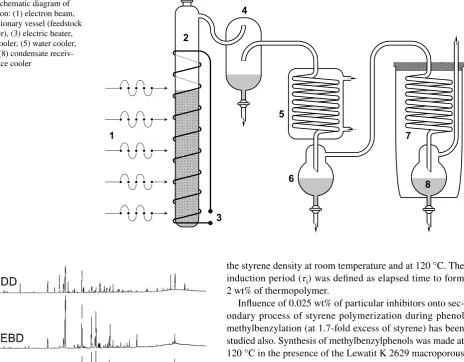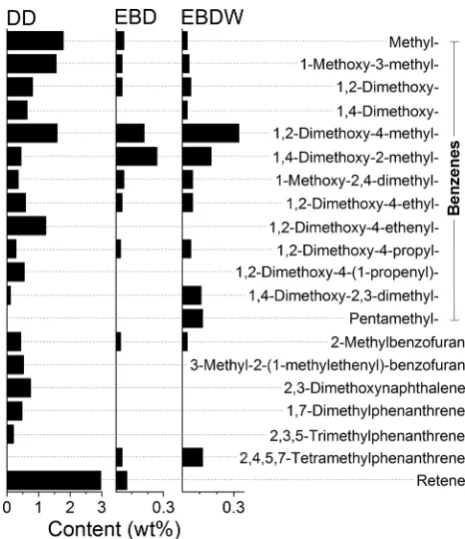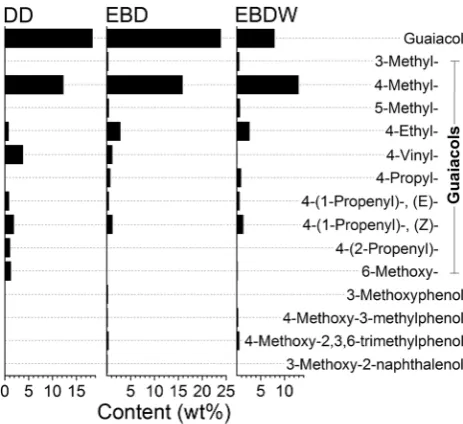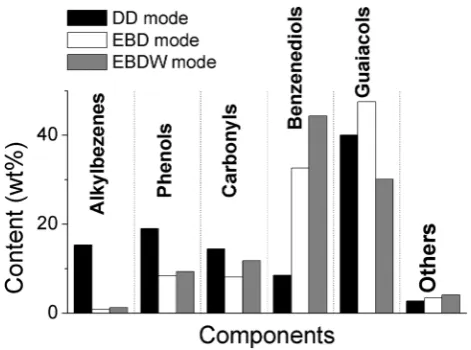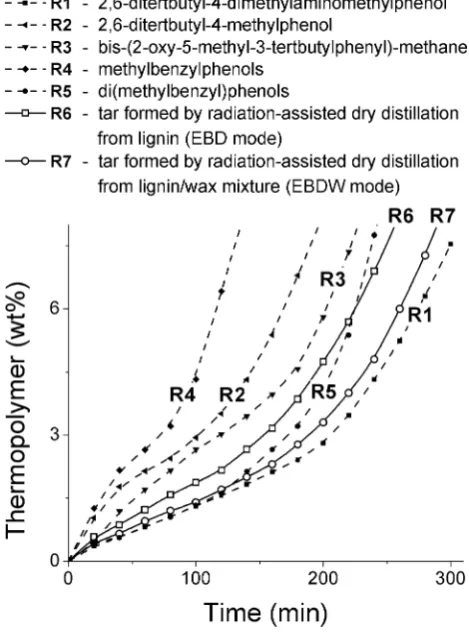https://doi.org/10.1007/s10086-018-1746-4
ORIGINAL ARTICLE
Thermopolymerization inhibitors generated via radiolysis of lignin
Igor N. Gorbarev1 · Alexander I. Kasterin1 · Polina K. Metreveli1 · Alexander V. Ponomarev1
Received: 2 March 2018 / Accepted: 22 June 2018 / Published online: 13 July 2018 © The Japan Wood Research Society 2018
Abstract
The pyrogenic conversion of lignin to a phenolic tar can be significantly enhanced by combining dry distillation with simulta-neous electron-beam treatment of lignin. The tar produced by the combined method contains three times more benzenediols in comparison with conventional pyrogenic distillation method. As shown, the tar of radiation-thermal origin can inhibit the thermopolymerization of certain monomers, such as styrene. The inhibiting ability of tar exceeds that of synthetic phenolic inhibitors. In the presence of 0.025 wt% of the tar, the induction period of styrene thermopolymerization at 120 °С is at least 120 min. Radiation-thermal formation of phenolic tar obeys the chain mechanism and thereby, is a highly efficient process.
Keywords Lignin · Radiolysis · Tar · Benzenediols · Polymerization retarders
Introduction
Many of the most commonly used monomers, such as sty-rene, are easily polymerized by heating. As a consequence, the use of polymerization retardants is necessary for the recovery, refining and storage of such monomers. Accord-ingly, the search for effective and safe polymerization retard-ers is an actual task.
Aromatic nitroxyl compounds or amines [1, 2], in par-ticular, 2,6-ditertbutyl-4-dimethylaminomethylphenol (Mannich’s base), are usually used in the modern industry to inhibit thermal polymerization of styrene. However, deg-radation products of such unstable inhibitors contaminate the monomer. Besides, arylamines and nitroxyls possess considerable toxicity. Therefore, despite high reactivity of such inhibitors, they should be replaced with less harmful compounds, in particular, inhibitors of phenolic type.
Phenols are quite often taken into consideration from the point of view of practical inhibition of monomers polymerization and polymers stabilization. For example, 2,6-ditertbutyl-4-methylphenol (Avox BHT), bis-(2-oxy-5-methyl-3-tertbutylphenyl)-methane (Vanox MBPC), mixed phenolic inhibitor (PC-16), and also various compositions
on the basis of technogenic phenols, are used as alternative polymerization retarders of styrene [3, 4]. Search of phe-nolic polymerization retarders also is important to advance researches on synthesis of new highly effective phenolic antioxidants via phenol/styrene interaction complicated because of secondary process of styrene polymerization [5].
The phenols forming by means of thermal processing of wood and coal are practically most available. The phenolic tar originating from wood is known since ancient times. It was used as lubricant, protective impregnant for wooden and leather products, insect repellant, odorant, cosmetic and edi-ble ingredient, spice for meat, natural dye for production of paints, chemical reagent, etc. Till now tar is widely used as bio-protection agent. In the last century, tar has been recog-nized as inexpensive and available polymerization retarder, in particular, as inhibitor of styrene thermopolymerization.
However, the phenolic tar forming by means of conven-tional dry distillation of wood contains low-reactive phe-nols and, as the consequence, possesses rather low inhibiting effect in comparison with phenols of a coke-chemical origin [3].
As shown earlier [6, 7], the dry distilling combined with an electron beaming gives the chance to change consider-ably composition and properties of the organic tar being produced from a vegetative feedstock. In the present work, the tar produced via the combined method from lignin has been tested as inhibitor of styrene thermopolymerization.
* Alexander V. Ponomarev ponomarev@ipc.rssi.ru
1 Frumkin Institute of Physical Chemistry
Experimental
Materials
The hydrolytic coniferous lignin (Polyphepan from “Scien-Tech”, Russia) containing 8.5 wt% of cellulose and intended for medical application has been used as feedstock. Mineral impurities were mainly represented by Na ( ≈ 1 wt%), Fe ( ≈ 0.1%) and Si (0.012%). The content of each of Al, Ca, Cr, Cu and Mg was not higher than 10−3 wt%, whereas the
content of Ag, B, Mn, Mo, Ni, Pb, Sn, Ti and Zn did not exceed 10−4 wt%. Such a composition of mineral impurities
is characteristic of polyphepan [8].
Tar has been obtained by three ways. The first way (DD mode) consisted of conventional dry distillation of lignin by means of muffle heating. The second way (EBD mode) provided a combination of dry distillation with electron-beam irradiation of lignin. Unlike EBD, the third way (EBDW mode) was to distill the feedstock containing equal quotas of lignin and wax. Mixture of С17–С120 solid
linear paraffins (wax) synthesized via Fischer–Tropsch process (from “Gazohim Techno”, Russia) served as addi-tive into lignin at EBDW mode. The content of C atoms per an average molecule of the wax was na = 28.6 and boil-ing range of the wax was 350–700 °С.
Individual aromatic compounds representing alkylated derivatives of benzene, phenol, guaiacol, vanillin and ben-zenediols (5–8 compounds from each group, from Sigma-Aldrich and Reachem) were used in chromatographic quantitative analysis of tar.
Styrene and thermopolymerization inhibitors were pur-chased from PJSC “Nizhnekamskneftekhim” (Russia). Sev-eral recognized phenolic retarders, including 2,6-ditertbu-tyl-4-dimethylaminomethylphenol (Mannichʼs base, R1), 2,6-ditertbutyl-4-methylphenol (Avox BHT, R2), bis-(2-oxy-5-methyl-3-tertbutylphenyl)-methane (Vanox MBPC, R3), methylbenzylphenols (R4) and di(methylbenzyl)phe-nols (R5), have been tested among comparison inhibitors. The R4 methylbenzylphenols mixture contained 42 wt% of 2-methylbenzylphenol and 58 wt% of 4-methylbenzylphe-nol. The R5 di(methylbenzyl)phenols mixture contained 43 wt% of 2,4-di (methylbenzyl)phenol and 57 wt% of 2,6-di(methylbenzyl)phenol. Lewatit K 2629 macroporous heterogeneous catalyst of acid type (from BAYER; effec-tive particle size, 0.5–0.62 mm; inner surface, 40–45 m2/g)
was used for synthesis of methylbenzylphenols.
Irradiation
Samples were irradiated by the accelerated electrons (UELB-10-10T linac; beam energy, 8 MeV; pulse duration, 6 µs; pulse
repetition frequency, 300 Hz; average beam current, 800 µA; scan width, 245 mm; and scan frequency, 1 Hz) under vacuum (5 mmHg) at 0.20 ± 0.01 kGy/s in 100 ml cylindrical quartz vessels without air access. Average bulk weight of samples was 0.15 g/ml. Film dosimetry with a phenazine dye-doped copolymer standard reference material SO PD(F)R-5/50 [GSO (Certified Reference Material) no. 7875-2000] was used.
Distillation
Distillation of lignin in DD, EBD and EBDW modes was per-formed using the same laboratory setup (Fig. 1). Under EBD and EBDW modes, the reaction vessel was placed in the irra-diation area. Three consecutive coolers–condensers (cooled accordingly by air at 17 ± 2 °С, by water at 15 ± 2 °С and by ice-water mix at ~ 0 °С) were located outside radiation area and were adjusted for roughing-out and devaporation of light fragmentation products. Gaseous products were liberated by inertial separation and were evacuated by a gas pump. In DD mode, the constant 150 W power of the electric heater was used. In the DD mode, the constant power 150 W of electric heater was used, which provided the temperature rise up to 520 °C. In EBD and EBDW modes, the power of the electric heater was 86 W, providing the ultimate heating to 220 °C (below the pyrolysis start point). Radiation heating with an electron beam increased the temperature in the sample by 110°.
Analysis
Gas chromatograph and mass spectrometer (Agilent 5977EMSD/7820AGC; helium as carrier gas; 60-m glass capillary column of 0.25 µm inner diameter) was used for analysis of tar. Typical chromatograms of the wax formed in the DD, EBD and EBDW modes are shown in Fig. 2. The NIST mass spectrometer library was used to identify the components of the wax. At least 99% of all components had mass spectra corresponding to known compounds included in the NIST library (91–99% similarity). Fractionation of the tar with a laboratory distillation column, as well as by chang-ing the temperature in the air cooler (4) in Fig. 1, was used to concentrate the individual fractions and thereby improve the identification of the components. However, about 0.65, 0.37, and 0.26 wt% of the components obtained in DD, EBD and EBDW modes, respectively, remained unidentified.
Inhibition test
Influence of phenolic inhibitors on styrene thermopolym-erization has been measured at 120 °С in N2 atmosphere.
Concentration of test inhibitor in styrene was 0.025 wt%. The thermopolymer content was determined by a dilato-metric technique [9]. The inhibitor and styrene were loaded into a clean dry dilatometer and deaerated with nitrogen for 5 min. The dilatometer was then placed in an air thermo-stat at 120 °C. Periodic measurements of the change in the volume of styrene (ΔV) and the amount of the formed ther-mopolymer were calculated from the ratio between ΔV and the initial volume V, taking into account the difference in
the styrene density at room temperature and at 120 °C. The induction period (τi) was defined as elapsed time to form 2 wt% of thermopolymer.
Influence of 0.025 wt% of particular inhibitors onto sec-ondary process of styrene polymerization during phenol methylbenzylation (at 1.7-fold excess of styrene) has been studied also. Synthesis of methylbenzylphenols was made at 120 °С in the presence of the Lewatit K 2629 macroporous heterogeneous catalyst of acid type. Viscosity of the syn-thesized liquids was estimated on the basis of their efflux velocity by means of capillary Ubbelohde viscometer.
Results and discussion
The yield of the decomposition products of lignin depends on the distillation mode used. In the DD mode, the water, gas and tar yields are 20 ± 2, 21 ± 1 and 12 ± 1 wt%, respectively. The use of irradiation in the distillation process (EBD mode) leads to an increase in the yield of tar (32 ± 2%) simultane-ously with a decrease in the yield of water (10 ± 2%), gases (18 ± 2%) and charcoal (40 ± 2%).
All aromatic products were assigned to five functional series (Table 1). Alkyl, alkenyl and methoxy derivatives of benzene and polycyclic hydrocarbons have been assigned to the alkylbenzenes series. Alkyl and alkenyl derivatives of phenol were assigned to the phenols series. Compounds that contain hydroxyl and a methoxy group have been included in the guaiacols series. Vanillin derivatives and other com-pounds containing carbonyl groups were assigned to the carbonyls series. Aromatic compounds with two hydroxyl groups were included in the benzenediols series. Table 1 Fig. 1 Schematic diagram of
distillation: (1) electron beam, (2) reactionary vessel (feedstock container), (3) electric heater, (4) air cooler, (5) water cooler, (6) and (8) condensate receiv-ers, (7) ice cooler
1
2
3 4
5
6
7
8
shows the structures of aromatic compounds whose deriva-tives dominate in each series. The quantitative composition of each series is shown in Figs. 3, 4, 5, 6 and 7.
Distinctions of the tar obtained from lignin via DD and EBD modes are shown on Fig. 8. DD mode gives lighter tar. Components whose boiling point is lower than 235 °С represent about 85 wt% of the tar. Among them there is the fraction (2.7 wt%) consisting of nonaromatic products of a fragmentation of lignin and extrinsic cellulose (acetone, methanol, light carboxylic acids, furfural, methylfurfural, furanmethanol, etc.). However, the prevailing fraction of tar consists of about 50 aromatic compounds among which alkylbenzenez, phenols, guaiacols, carbonyl compounds and benzenediols are the most significant. At the same time, among the carbonyl compounds ( ~ 14 wt%) the derivatives of dehydroabietic acid predominate, while the content of vanilloids is relatively small (4.8 wt%).
In comparison with DD mode, the EBD mode gives 13 times smaller quantity of aromatic products free of OH groups (alkylbenzenes series)—their total content in the tar is 1.2 ± 0.2 wt% (Figs. 3, 8). All other compo-nents of tar represented various phenols, including 64 wt% of monohydric phenols. The content of phenol itself was only 2.2 wt%. About 6 wt% of monohydric phenols falls to cresols and xylenols, whereas 7.5 wt% falls to vanillin and its derivatives. However, guaiacols are the main rep-resentatives of monohydric phenols at EBD mode. Among
them 2-methoxyphenol (guaiacol, 23.9%), 4-methyl-2-meth-oxyphenol (creosol, 15.9%), and 4-ethyl-2-meth4-methyl-2-meth-oxyphenol (2.8%) are prevailing (Fig. 5). Guaiacol and creosol domi-nation agrees with the fact that coniferous lignin represents a combination mainly of guaiacylpropane base units, i.e., coniferyl alcohol serves as the main monolignol [10]. The total radiation-chemical yield of tar components is about 30 µmol/J that testifies to the chain mechanism of their for-mation [11–13].
At the same time, almost the third part of tar (32.6 wt%) at EBD mode consisted of benzenediols about 69% of which have been represented by catechols (Figs. 7, 8). High yield of tar formation and the high content of benzenediols in the tar are the important advantages to radiation-stimulated distilla-tion vs pyrolysis. The tar originated via DD mode contains from 6 to 14 wt% of benzenediols [10]. The total yield of such tar formation is three times less than that at EBD mode.
The ionization of the lignin with the formation of the pri-mary radical–cation can occur in any structural unit of the macromolecule. However, aromatic units are statistically most preferable. In polar systems, the radical–cation, taking into account its instability, decomposes into a radical and a cation. Correspondingly, the appearance of a radical–cation in the phenol moiety (reaction (1)) and the subsequent pro-ton transfer (reaction (2)) with the formation of a phenoxyl
Table 1 Assigning products to series
e r u t c u r t s c i s a B e m a n s e i r e S
Alkylbenzenes O 2
3 4 5 6 7 1 2 3 4 5 6 7 8 1 2 3 4 5 6 8 9 10 7
Benzene Benzofuran Naphthalene Phenanthrene
Phenols OH 2 3 4 5 6 1 2 3 4 5 6 7 8 OH 1 2 3 4 5 6 7 8 OH 1
Phenol 1-Naphthol 2-Naphthol
Guaiacols HO OCH3 2 3 4 5 6 1 p-Guaiacol OH OCH3 2 3 4 5 6 1 m-Guaiacol OH OCH3 2 3 4 5 6 1 Guaiacol Carbonyls O 1 2 3 4 5 6 Acetophenone OH O HO O Phthalic acid OH OCH3 O 2 3 4 5 6 1 Vanillin Benzenediols HO OH 1 2 3 4 5 6 HO 1 2 3 4 5 6 OH HO 1 2 3 4 5 6 OH
Catechol Resorcinol Hydroquinone Fig. 3 Composition of the alkylbenzenes series in the tar formed via
Fig. 4 Composition of the phenols series in the tar formed via three modes of dry distillation. DD conventional dry distillation of lignin,
EBD radiation-assisted dry distillation of lignin, EBDW radiation-assisted dry distillation of lignin/wax mixture
Fig. 5 Composition of the guaiacols series in the tar formed via three modes of dry distillation. DD conventional dry distillation of lignin,
EBD radiation-assisted dry distillation of lignin, EBDW radiation-assisted dry distillation of lignin/wax mixture
Fig. 6 Composition of the carbonyls series in the tar formed via three modes of dry distillation. DD conventional dry distillation of lignin,
EBD radiation-assisted dry distillation of lignin, EBDW radiation-assisted dry distillation of lignin/wax mixture
radical and a fragment of the macromolecule with a proto-nated polar group should be considered as a key reaction scheme of the primary radiolytic transformations of lignin [11–14].
Reaction (1) precedes the formation of other important intermediates responsible for the fragmentation of lignin: radical–anions and H adducts. They appear as a result of the following reaction:
The conversion of the radical anion into the H adduct is simplified due to the presence of acids among the products of lignin radiolysis (for example, acetic acid). Structurally similar adducts result from the addition of H atoms to the aromatic units of lignin [12–14]:
OH OH
+ e- (1)
OH+HO O + O
H H
(2)
+ e- H+ H H
(3)
+
H H H
H
(4)
Typically, the aromatic radical is thermally degraded by cleavage of the bond in the β-position relative to the benzene ring [11–13]. The methoxy O–CH3 bond is in the β-position.
The low dissociation energy of the O–CH3 bond and the high concentration of methoxy groups in the lignin macromolecule are responsible for the high probability of CH3 elimination.
The benzene ring allows phenoxyl radicals to acquire a qui-noid structure with the arrangement of an unpaired electron on any of the carbon atoms. Thus, the bonds of almost any side substituent can occur in the β-position relative to the ring to increase the probability of their thermally stimulated cleavage. Thus, degradation with the elimination of aromatic fragments is one of the most important radiolytic transformations of lignin at high temperatures. Monohydric and dihydric phenols are the main liquid products of the degradation.
When the feedstock contains equal quotas of lignin and wax, the use of the EBDW mode leads to an increase in the series of benzenedioles (~ 44%) and carbonyls (~ 12%) (Fig. 8). At the same time, there is a decrease in the guaiacols series (~ 30%) of the tar (R7). Threefold reduction of the guaiacol fraction (from 23.9 to 7.9%) is observed, whereas fractions of 4-methylguaiacol and 4-ethylguaiacol are decreasing to 13 and 2.6%, respectively, but vinylguaiacol is present in the tar in negligible quantity (0.1%). At the same time, fractions of other alkyl derivatives of guaiacol slightly increase.
Collaterally with decreasing of guaiacols fraction in the tar (Figs. 5, 8), yields of all registered representatives of benzen-ediol series (Figs. 7, 8)—catechols, resorcinols and hydroqui-nones—are increasing. Apparently, such changes are caused by the intensified involving of guaiacols and/or their prede-cessors into the formation of benzenediols in the presence of alkanes in the mixture being irradiated.
Radiolysis of wax can be considered as a source of H and CH3 radicals, whereas aromatic units of lignin serve as
effec-tive scavenger of these radicals [12, 13]. Correspondingly, the cleavage of the weak O–CH3 bond of the methoxy group is the most probable reaction path of the high-temperature conver-sion of the H and CH3 adduct:
In turn, the addition of radical ·R (predominantly, H or СН3) to the benzenediol unit can lead to the thermally
stimu-lated β-cleavage of the propane bridge that connects this unit to the lignin macromolecule.
OH O CH3
H H
OH OH
CH3
+ (5)
OH OH
+ R
OH OH HR
CH3
OH OH
CH3
R
+
(6)
It is obvious that guaiacol and creosol can participate in the formation of catechols in reactions like reaction (5). In particular, they can be the direct precursors of 3-methyl-catechol and 3,4-dimethyl3-methyl-catechol, respectively. A possible reaction path in the propagation of chain fragmentation is the high-temperature reproduction of methyl radicals [12,
13].
Presence of the branched aromatic components possess-ing two or three vacant hydroxyl groups is positive from the point of view to use the tar as polymerization retarder [1–5]. Figure 9 illustrates kinetics of styrene thermopoly-mer formation in the presence of 0.025 wt% of various inhibitors (R1–R5 and tar). Apparently, all compared phenolic inhibitors are less effective in comparison with Mannich’s base, R1 (the curve 1, τi ≈ 160 min). Figure 9
shows significant influence of a structure of phenolic com-pounds on their inhibiting effect. So, the monosubstituted
OH O
+ CH3
CH3
OH O CH3
H CH3
OH OH CH3
+ CH3 (7)
phenols—methylbenzylphenols—are less efficient than disubstituted ones—di(methylbenzyl)phenols. Mixture of di(methylbenzyl)phenols (R5) and two species of radiation-originated tar (R6 and R7) display the inhibiting effect almost similar to that displayed by R1 reference inhibi-tor. Induction periods of styrene thermopolymerization at 120 °С in cases of R1 and R5–R7 inhibitors vary in a range of 110–160 min. At the same time R2–R4 industrial stabiliz-ers, as well as tar obtained at the DD mode, possess smaller effect in comparison with the radiation-originated tar.
Certainly, the tar has brown coloring. Accordingly, it con-siderably colors synthesized methylbenzyl derivatives. How-ever, viscosity of the phenols synthesized in the presence of 0.025 wt% of tar is approximately 4–5 times less (Table 2) than that obtained without inhibitor. Moreover, the product synthesized at presence of R2 or R5 also is more viscous than that in the presence of the tar (R6 or R7).
Conclusion
The molecular chain scission consisting in elimination of phenolic fragments is the main radiolytic transformation of lignin at high temperatures. Radiation stimulation of pyrog-enous decomposition of lignin provides possibility to obtain high yield of the beneficiated phenolic tar differing in com-position from a product forming via conventional dry distil-lation. The electron beam is convenient tool to initiate simul-taneous and uniform destruction of lignin. The radiolytic product represents a concentrate of methoxyphenols and the diatomic substituted phenols. As consequence, such tar can serve as the convenient and accessible additive to inhibit efficiently the styrene thermopolymerization. Besides, an inhibiting effect of the tar is higher than many industrial inhibitors.
Fig. 9 Formation of polystyrene at 120 °С in the presence of 0.025 wt% of various inhibitors
Table 2 The efflux time for methylbenzylphenols synthesized in the presence and absence of inhibitors
a R1—2,6-ditertbutyl-4-dimethylaminomethylphenol (Mannichʼs base); R2—2,6-ditertbutyl-4-methylphenol; R5—di(methylbenzyl)phenols; R6—tar formed by radiation-assisted dry distillation from lignin (EBD mode); R7—tar formed by radiation-assisted dry distillation from lignin/wax mixture (EBDW mode)
Inhibitora Efflux time (s)
R1 + R5 180
R2 540
R5 470
R6 460
R7 350
Acknowledgements Authors thank the CKP FMI IPCE RAS for tech-nical support (the linac and evaluators).
References
1. Córdova A, Watanabe S, Tanaka F, Notz W, Barbas CF (2002) A highly enantioselective route to either enantiomer of both α- and β-amino acid derivatives. J Am Chem Soc 124:1866–1867 2. Mitsumori S, Zhang H, Ha-Yeon Cheong P, Houk KN, Tanaka
F, Barbas CF (2006) Direct asymmetric anti-Mannich-type reactions catalyzed by a designed amino acid. J Am Chem Soc 128:1040–1041
3. Fiege H, Voges H-W, Hamamoto T, Umemura S, Iwata T, Miki H, Fujita Y, Buysch HJ, Garbe D, Paulus W (2000) Phenol deriva-tives. In: Ullmann’s encyclopedia of industrial chemistry. Wiley-VCH Verlag GmbH & Co. KGaA, Weinheim, pp 521–582 4. Moad G, Solomon D (1995) The chemistry of free radical
polym-erization. Elsevier, New York
5. Maul J, Frushour BG, Kontoff JR, Eichenauer H, Ott KH, Schade C (2007) Polystyrene and styrene copolymers. In: Ullmann’s ency-clopedia of industrial chemistry. Wiley-VCH Verlag GmbH & Co. KGaA, Weinheim
6. Ponomarev AV, Makarov IE, Ershov BG (2014) Electron-beam distillation of natural polymers. Radiat Phys Chem 94:221–225 7. Ponomarev AV (2009) Electron-beam decomposition of
phytog-enous substances: solid-to-liquid conversion. Radiat Phys Chem 78:345–350
8. Podterob AP, Bogdanovich YuV, Nizhnikova EV, Nechai OG (2004) Detoxicating properties of polyphepan evaluated in model experiments. Pharm Chem J 38:459–464
9. Hunkel M, Surm H, Steinbacher M (2018) Dilatometry. Handb Therm Anal Calorim 6:103–129
10. Fengel D, Wegener G (1984) Wood: chemistry, ultrastructure, reactions. Walter, New York
11. Woods R, Pikaev A (1994) Applied radiation chemistry. Radiation Processing. Wiley, New York
12. Ponomarev AV, Metreveli PK, Chulkov VN, Bludenko AV (2017) Formation of benzenediols upon electron-beam distillation of lignin mixtures with alkanes. High Energy Chem 51:380–385 13. Ponomarev AV (2017) Radiolysis of lignin: prospective
mecha-nism of high temperature decomposition. Radiat Phys Chem 141:160–167
